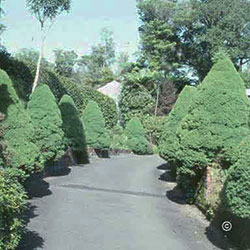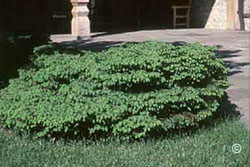Many homeowners are faced with a common problem – a huge tree dwarfing a home or building. Once a small tree, it has now outgrown its original site. Today’s trend to smaller yards means some trees will later dominate the landscape and limit other landscaping or gardening.
What is a dwarf conifer?
 Some alternatives to full-sized trees are available. Dwarf conifer is a term used to refer to evergreen trees that are genetically programmed to grow slowly and stay small. Specialty conifer is a term that may refer to dwarf evergreens or to trees with unusual growth habits, like weeping spruce or pines, that grow as a ground cover. Dwarf and specialty varieties are more expensive than standard varieties.
Some alternatives to full-sized trees are available. Dwarf conifer is a term used to refer to evergreen trees that are genetically programmed to grow slowly and stay small. Specialty conifer is a term that may refer to dwarf evergreens or to trees with unusual growth habits, like weeping spruce or pines, that grow as a ground cover. Dwarf and specialty varieties are more expensive than standard varieties.
Are all dwarf trees the same size?
Dwarf is a relative term, so before purchasing a dwarf or specialty conifer, find out its mature size and plan landscaping around that dimension.
Where should I plant my dwarf conifer?
When selecting a site, it is important to know how much sun the tree will get. Some specialty conifers prefer full sun, but others must have partial to full shade.
How can I keep the soil moist?
Apply wood chip mulch around the base of the tree to help keep the soil cool and moist. Dwarf conifers should be watered during warm spells or dry spells in the winter.
What are common dwarf conifers for Colorado?
 Some specialty conifers commonly sold in this area are dwarf Alberta spruce, bird’s nest spruce, Montgomery blue spruce, dwarf blue Scotch pine, compact white fir, dwarf blue alpine fir, dwarf Swiss stone pine, Blue Star juniper and dwarf shag white pine.
Some specialty conifers commonly sold in this area are dwarf Alberta spruce, bird’s nest spruce, Montgomery blue spruce, dwarf blue Scotch pine, compact white fir, dwarf blue alpine fir, dwarf Swiss stone pine, Blue Star juniper and dwarf shag white pine.
For “Challenging areas” refer to message number 1109.
For more information, see the following Colorado State University Extension fact sheet(s).



